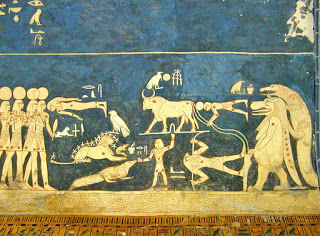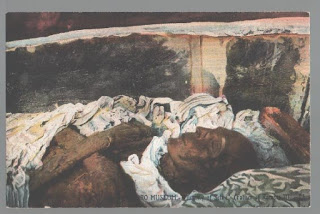Egypt

By the time Pharaoh Seti I was buried in 1279 BC he had restored Egypt to the former glory lost during the Amarna period of a half century earlier. Seti left as tribute to his reign temples such as at Abydos with some of the finest raised reliefs known in Egyptian art of the New Kingdom. Seti's fourteen year long reign also resulted in one of the finest tombs ever constructed in Egypt, and certainly the finest in the Valley of the Kings at Thebes.

With only Tutankhamun's mummy left undisturbed it cannot be judged today if this mixture of names on the amulets surrounding the body of the king was unique to Tutankhamun or common practice in the New Kingdom.
Notes:
Tomb of Seti I- Jean-Pierre Dalbera
Mummy of Seti I
The Theban Royal Mummy Project
X-Raying The Pharaohs; James E. Harris and Kent R. Weeks, Charles Scribner's Sons, New York, 1973. SBN 684-13016-5, page 43
- Lecture: Fragments From Kv17
http://touregypt.net/teblog/luxornews/?p=412More thanks to Jane Akshar for her regular note-taking at the Mummification Museum in Luxor. This week she has posted her notes for a lecture by Dr Florance Mauric-Barberio on the subject of painted fragments...
- Tuesday's Egyptian: The Lost Mummy Of King Kamose
Why...
- The Cave Of Sokar
This is Dr. Hawass on the tunnel in the tomb of Seti I in the Valley of Kings which his team have recently finished excavating. Dr. Hawass explains the tunnels meaning including the Kings plan of building a tomb within the tomb but Seti's time ran...
- The End Of Seti's Tomb
...
- Wv 22?
I have noticed on a number of sites that one of the mummies recently studied by Dr. Hawass has been given the designation of WV 22. The mummy in question was found in the Valley of kings in KV 35 in a side chamber with an inscription identifying it as...
Egypt
Tuesday's Egyptian
The Eye of Re on the Mummy of Pharaoh Seti I

By the time Pharaoh Seti I was buried in 1279 BC he had restored Egypt to the former glory lost during the Amarna period of a half century earlier. Seti left as tribute to his reign temples such as at Abydos with some of the finest raised reliefs known in Egyptian art of the New Kingdom. Seti's fourteen year long reign also resulted in one of the finest tombs ever constructed in Egypt, and certainly the finest in the Valley of the Kings at Thebes.
Seti's gorgeous tomb walls were prepared with all the spells he would need to find his way through the underworld in safety. As the king's body was being mummified by priests, workers carefully filled the chambers of his tomb with every provision Seti was going to need for his reign in the afterlife. His tomb would have contained his favorite foods, his clothes, regalia and furniture he used in life, including his thrones and even his chariots.
Some seven hundred magical figures who would do Seti's work for him were also placed within his sepulcher, and among the few things found still in the tomb when Giovanni Belzoni discovered it in 1817. Seti's alabaster sarcophagus being the great prize still in the tomb except by then its lid had been smashed and King Seti's mummy long gone.

More than a half century after Belzoni left Seti's tomb the great king's mummy turned up, not in the Valley of the Kings but in a cliff tomb at Deir el Bahri. In the tomb with Seti was his son the great Ramses II, and a who’s who of the New Kingdoms greatest rulers. In this long undisturbed tomb Seti rested in the entrance corridor in one of his original wood coffins, which had had its face refashioned. Inside the king's damaged mummy and original tattered wrappings were covered with a yellow shroud. When the shroud was pulled back Seti's remarkable noble disposition presented the face from his monuments in dignity, not as a dead man but as a sleeping monarch.
In the late 1960's X-rays revealed an impressive Eye of Horus amulet under the wrappings of Seti's upper left arm. The thought occurred to me that Tutankhamun's mummy contained amulets created for not only Tutankhamun but also for Akhenaten and Smenkhkare. I wondered if the amulet had ever been removed from Seti’s wrappings, something I have long been against, but now I wonder if the amulet is inscribed and if it bears Seti's name or his son Ramses II, or his father Ramses I, or even perhaps a leftover from Horemheb's burial.
Notes:
Tomb of Seti I- Jean-Pierre Dalbera
Mummy of Seti I
The Theban Royal Mummy Project
X-Raying The Pharaohs; James E. Harris and Kent R. Weeks, Charles Scribner's Sons, New York, 1973. SBN 684-13016-5, page 43
- Lecture: Fragments From Kv17
http://touregypt.net/teblog/luxornews/?p=412More thanks to Jane Akshar for her regular note-taking at the Mummification Museum in Luxor. This week she has posted her notes for a lecture by Dr Florance Mauric-Barberio on the subject of painted fragments...
- Tuesday's Egyptian: The Lost Mummy Of King Kamose
Why...
- The Cave Of Sokar
This is Dr. Hawass on the tunnel in the tomb of Seti I in the Valley of Kings which his team have recently finished excavating. Dr. Hawass explains the tunnels meaning including the Kings plan of building a tomb within the tomb but Seti's time ran...
- The End Of Seti's Tomb
...
- Wv 22?
I have noticed on a number of sites that one of the mummies recently studied by Dr. Hawass has been given the designation of WV 22. The mummy in question was found in the Valley of kings in KV 35 in a side chamber with an inscription identifying it as...
